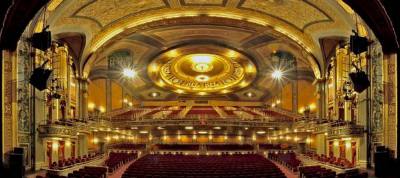 Waterbury, Connecticut's
Waterbury, Connecticut's
Palace Theater
by Louis Belloisy - Click images to enlarge |
|
I was a very happy young man; I had just graduated from high
school, had a new (used) red Chevy convertible and was starting
a job for the first time in my young life. I was going to be
an usher at the Loew's Poli Theater in Waterbury, Connecticut.
Life was easy then and downtown Waterbury was a bustling place
with wonderful stores lining both sides of East Main Street.
All stores were closed on Mondays but were open late on Thursday
nights, when everyone came to town to shop and of course take
in a wonderful movie at the Poli.
The Poli was a dream of Sylvester Z. Poli, who enlisted the
talent of famous architect, Thomas Lamb of Manhattan, NY. The
building was completed and opened to the public on January 28,
1922. At the same time, a sister theater was being built in Bridgeport,
which opened on September 4, 1922.
Unfortunately, it's hard to find agreement on seating capacities.
Sometimes they were reported incorrectly when the theaters first
opened. Sometimes they were later reduced but not reported. Having
seen the original floor plans, oh so many years ago, I can tell
you that the Waterbury Poli along with the sister theater in
Bridgeport had original seating capacities of more than 3700
seats; the one in Waterbury topped the list with 3719 seats.
The cost to build the Waterbury Theater was an outstanding
one million dollars, a grand price in the early 1920's. Mr. Poli
wanted his theater to be the best there was and to this day,
she still is.
Mr. Poli retired in 1934 and sold his interests to the Loew's
group. The historically correct name of the theater was Poli's
Palace and after the sale it was knows as Loews Poli Palace.
The Poli started out with vaudeville and silent movies; gradually
as technology progressed, it went to "talkies" and
to the grand movies of the 1950's and 60's. |

|
My early association with the Poli lasted 6 years until I entered
the Air Force and continued on with my career in flying. While
I worked for the Poli, I was usher, ticket taker, concession
person, assistant manager and the highlight of my work with the
Poli was when I was promoted to projectionist. To this day, I
still work part time as a projectionist in a local theater; it's
still in my blood. |
|
Speaking of grand movies, I remember the biggest movie of
my time at the Poli was the opening of MGM's Quo Vadis. This
was anxiously awaited as the most important movie to show in
Waterbury. All along the front of the theater on East Main Street
were many gas fired World War II searchlights, which played the
skies before the opening of the movie. It was the longest movie
that we had ever shown, a total of 4 hours with a long intermission
half way. It stared Robert Taylor, Deborah Kerr, Leo Genn, and
Peter Ustinov along with many more fine actors, most of whom
are no longer with us.
Early in 1952 a new movie technique made its appearance in
Manhattan, it was called Cinerama. It used three different cameras
to photograph and three different projectors showing the film
at the same time. Loew's Waterbury decided to join in the Cinerama
frenzy and installed a full size system in the Waterbury Theater.
Our normal projection screen was 65 feet in width; the Cinerama
screen was 146 feet in width, with a curve creating almost a
180-degree panorama. State of the art sound systems were installed
which included a 7-channel speaker system behind the behemoth
of a screen. There were also numerous speakers placed along the
walls and the corners of the theater. It was a smashing success;
the theater audiences were immediately plunged into the world
of a surround movie, many getting sick from the special effects,
especially the roller coaster ride. When the system was removed,
the seats that were removed for its installation were never replaced;
this lowered the seat count to less than 3000. The current seating
capacity of the Palace is 2640.
I did not enter the theater again until many years later when
I volunteered to work on the staff of the newly renovated Palace.
The first time I entered the theater after so many years, I almost
cried. I was astonished to see the magnificent restoration. |
|
As patrons enter the theater it's through a new entrance way,
which once was the lobby of the old Palace Hotel. You enter the
Grand Lobby through a hallway from the new box office. As you
look at the Lobby, you will notice very few modifications, though
railings along the Grand Staircase have been installed for safety.
All lights, with the exception of the three magnificent chandeliers
have been replaced with new ones. |
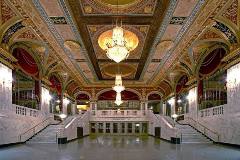 |
|
Most mirrors along the lobby are original. Look closely and you
will see the silver backing parting from the glass; they are
83 years old. The Grand Staircase is a movie star in itself.
Some scenes from Hello Dolly were filmed in the lobby, as were
several scenes in some of Kathryn Hepburn's movies. |
|
Walk through the doors to the main orchestra area, and you
will no longer see straight through to the stage, as it was before
the restoration. A wall has been installed just past the opening
to the balcony, eliminating about 10 rows of the back seats.
Along the new wall is a very tasteful wet bar. Walk from the
outer orchestra area into the main auditorium and you will immediately
notice that it is very quiet. The new wall serves two purposes,
one for the installation of the bar and the other to enhance
the sound quality of the lower orchestra.
The orchestra floor once slanted from the back of the theater
to the stage area. Now there are several steps that you have
to descend to get to the lower orchestra. By changing the slope
of the floor, they have created an effect similar to stadium
seating. When Mr. Poli built the theater, he wanted every seat
to have an unobstructed view of the stage, and it remains that
way today.
The back of the building and the old stage have been removed
and a new 5000 square foot building and stage have been built
-- big enough to accommodate any Broadway show that might come
to Waterbury.
When you look around the main orchestra area you immediately
see the magnificent organ pipes that are on both sides of the
theater. Contrary to what people might think, there never was
an organ in the Palace Theater; the pipes are strictly for decoration.
During the early movies they would have a small organ installed
by the stage, not at all connected to the big pipes. |
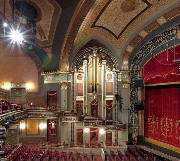 |
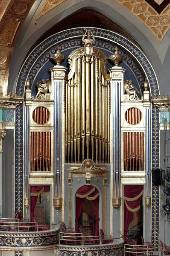 |
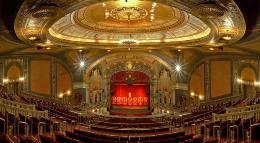
Balcony |
Walk up to the balconies and you will notice that nothing
has really changed except for safety railings along the stairway.
The seating arrangement in the balcony has not been altered.
The crown of the Palace is the lighted dome over the balconies.
It is truly a masterpiece serving two purposes, one decorative
and the other to enhance the sound qualities of the theater.
It is a true parabolic reflector, 64 feet in diameter. |
|
All seats are new as are the carpeting and drapery. Conrad
Schmitt Studios, Inc. has completed extensive restoration of
the decorative finishes, including ornamental plaster and scagliola,
decorative painting, millwork, metal work and terrazzo flooring.
The re-opening of the Palace Theater was on November 12, 2003
with Tony Bennett. It was a smashing sold-out event. There have
been many additional successful shows since the opening.
On this night, they had the official lighting of the "Ghost
Light" to mark the official opening of the theater. For
those who do not know what a ghost light is, here is a brief
explanation:
A ghost light is lighted on the stage for two reasons -- one
more practical and the second more fun. The first reason for
the ghost light is so when someone walks into backstage of the
dark theater they don't trip over set pieces and hurt themselves
or accidentally walk off of the edge of the stage. The second
reason is that, back in Shakespeare's time, candles were burned
in theaters to scare away ghosts of old performances. Many theaters
burned down from the simple fact that fire and wood don't mix.
Since we now have electricity, this is not a problem. Tradition
also has it that a working theater must never to dark.
I am very fortunate to be a part of the Palace Guard and I
give tours of the theater. I get so wound up on some of these
that I practically have to be "hooked off the stage".
I am proud to say that I am a Friend of the Palace. |
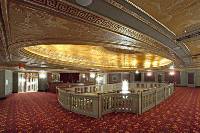
Mezzanine |

^ Stage | Lobby chandeliers > |
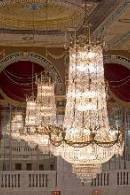 |
Virtual Tours of the Palace Theater
Profile
- Lou Belloisy
Lou's fabulous photos and articles can be found
throughout our pages
and those of WGI
ONLINE Journal
|
